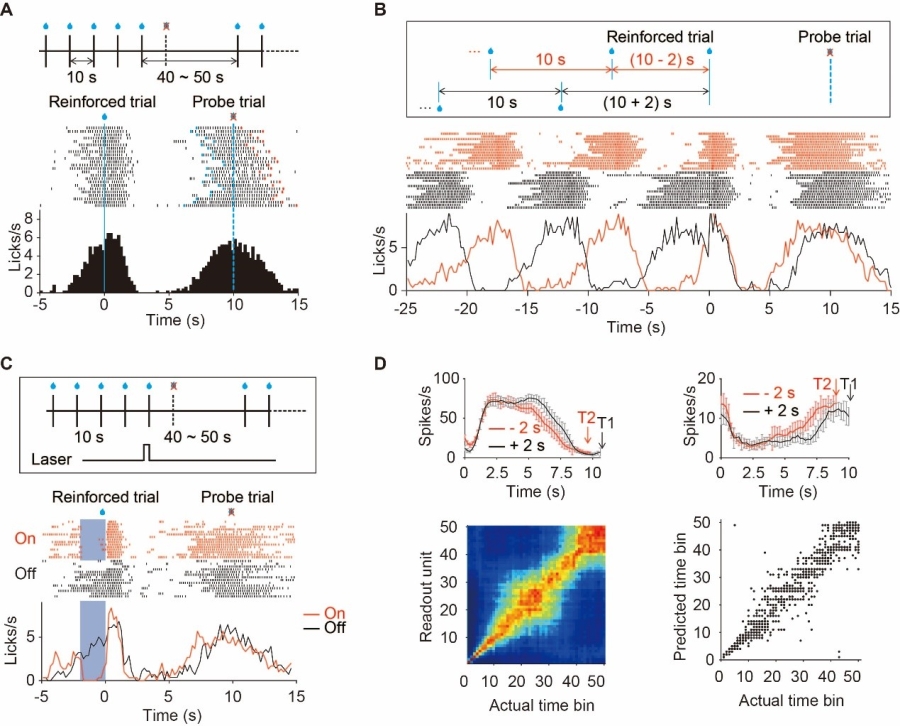Time:2022-10-10
A recent study published in Neuroscience Bulletin reveals that interval timing behavior is adaptive to recent experience of temporal interval and neuronal activity in the anterior lateral motor cortex (ALM) contributes to the short-term memory of time interval. This work was performed by researchers in Dr. YAO Haishan’s Lab at the Institute of Neuroscience, Center for Excellence in Brain Science and Intelligence Technology of the Chinese Academy of Sciences, State Key Laboratory of Neuroscience.
The ability to estimate elapsed time and produce timed responses is critical for a wide range of behaviors. Interval timing, which is on the scale of hundreds of milliseconds to tens of seconds, contributes importantly to cognitive behaviors, such as associative learning, sensory-motor processing, and decision making. Estimation of time interval can be influenced by non-temporal context, such as attention, emotional experience, and anxiety. There is also evidence showing adaptive timing behavior in changing temporal context. However, it remains poorly characterized how interval timing behavior is influenced by recent experience of temporal interval, and it is unclear which brain regions exhibit history-dependent activity in timing task.
The authors examined dynamic behavior of interval timing in head-fixed mice using a licking-based peak-interval timing procedure, in which the fixed-interval reinforced trials allowed the animal to establish memory representation for the target interval and the non-rewarded probe trials were used to measure the timing performance. They found that time estimation during probe trials was rapidly influenced by a decrease of inter-reinforcement interval in previous trial. Optogenetic inactivation of the ALM during a short period before reward delivery resulted in earlier anticipatory licking in the probe trial, whereas inactivation of the medial prefrontal cortex or a central and medial subregion of the secondary motor cortex did not affect the peak time of anticipatory licking. During probe trials preceded by an inter-reinforcement interval shorter or longer than usual, a subpopulation of ALM neurons exhibited temporal scaling in their response profiles. Support vector machine decoding analysis showed that population ALM activity could encode elapsed time and the representation was scalable.
In summary, Dr. Yao’s lab demonstrates that interval timing behavior is influenced by trial history, and neuronal activity in the ALM is modulated by the interval in previous trial.
This work entitled “Influence of Recent Trial History on Interval Timing” was published online in Neuroscience Bulletin on October 8, 2022. This work was completed by Dr. Xie Taorong, under the supervision of Dr. YAO Haishan, with help from HUANG Can, Zhang Yijie, and LIU Jing. This work was supported by grants from Ministry of Science and Technology, National Natural Science Foundation of China, Chinese Academy of Sciences, and Shanghai Municipal Government.

Interval timing behavior is influenced by trial history
Figure legend: A. Licking-based peak-interval timing task. B. Peak time is shifted earlier when the previous inter-reinforcement interval is shorter. C. Optogenetic inactivation of the ALM before reward delivery shifts peak time earlier in the probe trials. D. ALM neurons show temporal scaling in their response profiles and can encode elapsed time.
Key words: Recent Trial History ; Interval Timing
AUTHOR CONTACT
YAO Haishan, Ph.D.
Center for Excellence in Brain Science and Intelligence Technology, Chinese Academy of Sciences, Shanghai, China.
Email:haishanyao@ion.ac.cn
 附件下载:
附件下载: